20 November 2013 / Acting Archives, Marathon ⟶
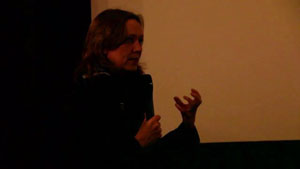
Stefanie Schulte Strathaus
Stefanie Schulte Strathaus presents the history of the Arsenal Institute for Film and Video Art, its beginnings as an institution, and the need for such an institution in Berlin. Several issues are raised in discussion about the politics of maintaining a film archive, especially in relation to its own collection and to the city that houses it. Two projects are highlighted, The Living Archive and The Visionary Archive, collaborations that have resulted from projects with a number of practitioners and other archives from around the world.
Synthesis
Arsenal Institute for Film and Video Art • Berlin Film Festival • Archive of 10,000 films • The films in Arsenal’s archive have only one purpose: to be shown • Anthology Film Archives in New York • Expand...
Arsenal Institute for Film and Video Art • Berlin Film Festival • Archive of 10,000 films • The films in Arsenal’s archive have only one purpose: to be shown • Anthology Film Archives in New York • Started as association called Freunde der Deutsche Kinemathek • No alternative cinema in Germany in the 60s • An important aspect of Arsenal was the combination of film history with contemporary film practice • Lionel Rogosim – film Come Back Africa: the first film in the archive, the basis of the collection and the beginning of distribution • Michael Verhoeven – film OK • The start of the Forum of Young Cinema • International films first collected at the initiative of the festival to subtitle them • Films sent from countries under military dictatorships • What to do with old print vs. DVD? • Old prints get vinegar syndrome • Too costly to digitise everything • Films are not categorised in the collection • The Living Archive project • Many of the films exist only in this collection • Archive as a practice: archiving films, curating films, restoring films, showing films • Opening an archive is not threatening an archive • Avi Mograbi and Angela Melitopoulos in The Living Archive project • The Visionary Archive • Attempting to run an institution without being an institution • Erika and Ulrich Gregor are still part of Arsenal • Preserving the memory of the institution itself • The Living Archive attracted partners from other countries • Filmmaker Gadalla Gubara • Guinea Bissau and Egypt forming film archives • The Visionary Archive works with these emerging archives • Restoration also part of the institution’s work
Short biography
Stefanie Schulte Strathaus, film and video curator, co-director of the Arsenal Institute for Film and Video Art, member of the selection committee of the Berlinale Forum, Expand...
Stefanie Schulte Strathaus, film and video curator, co-director of the Arsenal Institute for Film and Video Art, member of the selection committee of the Berlinale Forum, and founding director of Forum Expanded, a section of the Berlin International Film Festival that negotiates the boundaries of cinema. Her curatorial work comprises numerous film programmes, retrospectives, and exhibitions, among them The Living Archive – Archive Work as a Contemporary Artistic and Curatorial Practice.
Stefanie Schulte Strathaus stellt die Geschichte des Arsenal – Institut für Film und Videokunst vor und spricht über die Notwendigkeit einer solchen Institution in Berlin. Die Diskussion berührt folgende Aspekte: die politischen Rahmenbedingungen für die Pflege eines Filmarchivs, die Bedeutung der eigenen Filmsammlung und die Rolle des Archivs für die Stadt Berlin. Zwei Projekte werden insbesondere erwähnt, The Living Archive und The Visionary Archive; beide involvieren Beteiligte und verschiedene andere Archive weltweit.
Synthese
Arsenal Institute for Film and Video Art • Berlinale • Archiv mit 10,000 Filmen • Die Filme im Archiv des Arsenal haben nur einen einzigen Zweck: Gezeigt zu werden • Anthology Film Archives in New York • Expand...
Arsenal Institute for Film and Video Art • Berlinale • Archiv mit 10,000 Filmen • Die Filme im Archiv des Arsenal haben nur einen einzigen Zweck: Gezeigt zu werden • Anthology Film Archives in New York • Entwickelte sich aus einem Verband namens Freunde der Deutsche Kinemathek • In den 1960er Jahren gab es kein alternatives Kino in Deutschland • Wichtiger Aspekt des Arsenal war die Kombination aus Filmgeschichte mit zeitgenössischen Filmpraktiken • Lionel Rogosim – Film Come Back Africa: Erster Film im Archiv, Grundlage der Sammlung und Ausgangspunkt des Vertriebs • Michael Verhoeven – Film OK • Beginn des Forum of Young Cinema • Internationale Filme wurden zuerst auf Initiative des Festivals gesammelt um sie mit Untertiteln zu versehen • Filme aus Ländern mit Militärzensur erhalten • Was tun mit alten Filmrollen vs. DVD? • Alte Filme bekommen Essig-Syndrom • Zu kostspielig alles zu digitalisieren • Filme in der Sammlung sind nicht kategorisiert • The Living Archive Projekt • Viele Filme existieren nur in der Sammlung • Archive als Praxis: Filme archivieren, kuratieren, restaurieren und zeigen • Ein Archiv eröffnen ist keine Bedrohung für Archive • Avi Mograbi und Angela Melitopoulos im The Living Archive Projekt • The Visionary Archive • Versuch eine Institution zu führen ohne eine Institution zu sein • Erika und Ulrich Gregor sind immer noch Teil des Arsenal • Das Andenken an die Einrichtung selbst erhalten • The Living Archive lockt Partner aus anderen Ländern an • Filmemacher Gadalla Gubara • Guinea Bissau und Ägypten begründen Filmarchive • The Visionary Archive arbeitet mit diesen entstehenden Archiven • Restauration ist auch Teil der Arbeit des Archivs
Kurzbiografie
Stefanie Schulte Strathaus, Film- und Videokuratorin, Co-Direktorin des Arsenal - Institut für Film- und Videokunst, Mitglied des Auswahlkommittees des Berlinale Forums Expand...
Stefanie Schulte Strathaus, Film- und Videokuratorin, Co-Direktorin des Arsenal - Institut für Film- und Videokunst, Mitglied des Auswahlkommittees des Berlinale Forums und Gründerin und Leiterin des Forum Expanded, einem Bereich des Berlin International Film Festivals, der die Grenzen des Kinos auslotet. Ihre kuratorische Arbeit umfasst zahlreiche Filmprogramme, Retrospektiven und Ausstellungen, unter anderem The Living Archive – Archive Work as a Contemporary Artistic and Curatorial Practice.
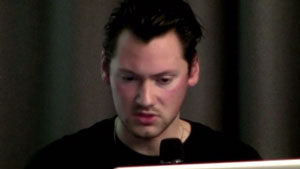
Felix Melia
Felix Melia explores several questions through his work, such as the semiotics of space, architecture and infrastructure, cultural and narrative appropriation via the Internet, and the relationships between self and space.
Synthesis
Representational space and the semiotics of space • The means by which we engender different kinds of environments with different types of meaning • Architectural infrastructure • Vast Montage • Expand...
Representational space and the semiotics of space • The means by which we engender different kinds of environments with different types of meaning • Architectural infrastructure • Vast Montage • Collating physical encounters within space • Superimposition of narratives onto environments • Meaning through the Kuleshov effect • Cultural and narrative appropriation via the Internet • Hood 2 Hood: The Blockumentary • A sense of identity based not on a city • The psychological presence of the self within the space • Samuel Beckett’s Endgame • Digital dualism • Nathan Jurgenson • Gentrification and regeneration of large cities
Short biographyFelix Melia, artist working across video, film, and sculpture. He has presented work most recently at the Biennale of Moving Image at the Centre d’Art Contemporain, Geneva.
Felix Melia erforscht mit seinen Arbeiten Fragen nach der Semiotik des Raumes, Architektur und Infrastruktur, kulturellen und narrativen Appropriationen über das Internet sowie die Beziehung zwischen Selbst und Raum.
Synthese
Repräsentative Räume und die Semiotik des Raums • Mittel durch die wir verschiedene Umgebungen mit verschiedenen Bedeutungen ausstatten • Architektonische Infrastruktur • Vast Montage • Expand...
Repräsentative Räume und die Semiotik des Raums • Mittel durch die wir verschiedene Umgebungen mit verschiedenen Bedeutungen ausstatten • Architektonische Infrastruktur • Vast Montage • Physische Begegnungen Räumen zuordnen • Narrative auf Umgebungen übertragen • Bedeutungsschaffung durch den Kuleshov Effekt • Kulturelle und narrative Appropriationen durch das Internet • Hood 2 Hood: The Blockumentary • Ein Identitätsgefühl das nicht auf einer Stadt beruht • Die psychologische Präsenz des Selbst im Raum • Samuel Becketts Endgame • Digitaler Dualismus • Nathan Jurgenson • Gentrifizierung und Regeneration großer Städte
KurzbiografieFelix Melia, Künstler, der mit Video, Film und Bildhauerei arbeitet. Er präsentiert seine neuesten Arbeiten auf der Biennale of Moving Image im Centre d’Art Contemporain in Genua.
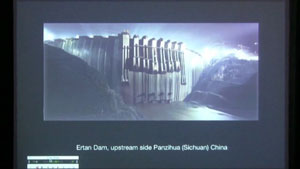
Armin Linke
Armin Linke presents his work, which focuses on questions of how to employ and think with images, especially from an archival perspective. He also discusses the relation between the Internet and architectural space, looking at the anthropological use of architecture.
Synthesis
Different ways to think and work with images • HfG Karlsruhe / ZKM • Project collaboration with Doreen Mende and Wilfried Kühn • Architettura • Collaboration with Alex Rich and Peter Hanappe • Expand...
Different ways to think and work with images • HfG Karlsruhe / ZKM • Project collaboration with Doreen Mende and Wilfred Kühn • Architettura • Collaboration with Alex Rich and Peter Hanappe • Sony CSL Lab • Insurance companies do not insure artwork that can be touched • Oscar Niemeyer • Early project: an online image archive – shown at the Utopia Station, Venice Biennale • To bring the structure of the internet into the architectural space • Carlo Mollino • Anthropological use of architecture • The changing landscape of rural Italy through architecture • Bruno Latour • An Inquiry Into Modes of Existence • Phenotypes/Limited Forms • Performative installation • Using an algorithm to select the images • MMK – Museum für Moderne Kunst, Frankfurt a.M. • Making History • Corrado Calvo
Short biography
Armin Linke, artist working with film and photography, with an ongoing archive on human activity and natural and manmade landscapes. Expand...
Armin Linke, artist working with film and photography, with an ongoing archive on human activity and natural and manmade landscapes. He is a professor at the HfG (Hochschule für Gestaltung) Karlsruhe, a guest professor in Arts and Design at the IUAV University in Venice, and a research affiliate at MIT Visual Arts Program Cambridge. He co-curated the project Double Bound Economies (2013), and together with Territorial Agency and Anselm Franke, he conceptualised and executed the Anthropocene Observatory video series at Haus der Kulturen der Welt, Berlin. Linke is also a part of Travelling Communiqué: Reading a Photo Archive (1948-1980).
Armin Linke präsentiert seine Arbeit mit einem Schwerpunkt auf Fragen wie man mit Bildern denken und arbeiten kann, besonders aus einer archivischen Perspektive. Er diskutiert außerdem auch die Beziehung zwischen Internet und architektonischem Raum und betrachtet hierbei die anthropologische Verwendung von Architektur.
Synthese
Unterschiedliche Arten mit Bildern zu denken und zu arbeiten • HfG Karlsruhe / ZKM • Projektzusammenarbeit mit Doreen Mende und Wilfried Kühn • Architettura • Expand...
Unterschiedliche Arten mit Bildern zu denken und zu arbeiten • HfG Karlsruhe / ZKM • Projektzusammenarbeit mit Doreen Mende und Wilfred Kühn • Architettura • Zusammenarbeit mit Alex Rich und Peter Hanappe • Sony CSL Lab • Versicherungen versichern keine Kunstwerke die berührt werden dürfen • Oscar Niemeyer • Frühes Projekt: Ein Online Bildarchiv – gezeigt in der Utopia Station, Venice Biennale • Die Struktur des Internets in den architektonischen Raum bringen • Carlo Mollino • Anthropologische Verwendung von Architektur • Die sich durch Architektur verändernde Gestalt des ländlichen Italiens • Bruno Latour • An Inquiry Into Modes of Existence • Phenotypes/Limited Forms • Performative Installation • Verwendung eines Algorithmus zur Auswahl von Bildern • Museum für Moderne Kunst, Frankfurt a.M. • Making History • Corrado Calvo
Kurzbiografie
Armin Linke, Künstler. Er ist Professor an der HfG (Hochschule für Gestaltung) Karlsruhe, Expand...
Armin Linke, Künstler. Er ist Professor an der HfG (Hochschule für Gestaltung) Karlsruhe, Gastprofessor für Kunst und Design an der IUAV Universität in Venedig und am MIT Visual Arts Program in Cambridge, USA. Er co-kuratierte das Projekt Double Bound Economies (2013) und konzeptualisierte und realisierte zusammen mit Territorial Agency und Anselm Franke die Anthropocene Observatory Videoreihe am Haus der Kulturen der Welt in Berlin. Linke ist außerdem Teil von Travelling Communiqué: Reading a Photo Archive (1948-1980).
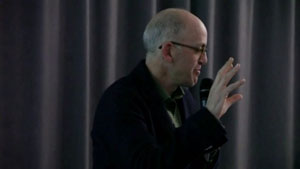
Jonathan Ledgard
Jonathan Ledgard raises several questions in relation to the arrival of new technologies and infrastructures in Africa and how these have an impact on African development, both culturally and politically. He also discusses how these technologies bring with them foreign interests and expectations, which have a direct effect on Africa as a whole.
Synthesis
Big ideas about archiving and memory • Working for The Economist • Joining love of Africa, technology, and creativity • The archiving of the human brain – reverse engineering • The Merowe people of Sudan have their archive in the elements • Expand...
Big ideas about archiving and memory • Working for The Economist • Joining love of Africa, technology, and creativity • The archival of the human brain – reverse engineering • The Merowe people of Sudan have their archive in the elements • Technology is not the be-all and end-all • A youthful China shakes hands with a shy Africa • The Nokia 1100 – the most influential technology in Africa in the last fifty years • Life recording – an entire life compressed and stored • IBM predicts a tsunami of data • How will future generations of Africans relate to their past? • Africa has a history of non-archival practice • Digital data implies the recording of the present • Attitudes toward Africa will have to change in the future • The dangers of digital identities being controlled by the state and corporations
Short biography
Jonathan Ledgard, thinker on near future nature, technology, and politics. Director of the Afrotech initiative at the Swiss Federal Institute of Technology in Lausanne, Expand...
Jonathan Ledgard, thinker on near future nature, technology, and politics. Director of the Afrotech initiative at the Swiss Federal Institute of Technology in Lausanne, where he works to pioneer advanced technologies on a massive scale in Africa through projects including the development of virtual coins and cargo robots. A long-time Africa correspondent for The Economist who has reported stories from 50 countries and on several wars, he is the author of two critically acclaimed novels, Giraffe (2006) and Submergence (2013).
Jonathan Ledgard hinterfragt die Einführung neuer Technologien und Infrastrukturen in Afrika und wie diese die Entwicklung in Afrika sowohl kulturell als auch politisch beeinflussen. Er diskutiert außerdem auf welche Weise diese Technologien fremde Interessen und Erwartungen mit sich bringen, die einen direkten Einfluss auf Afrika als Ganzes haben.
Synthese
Große Vorstellungen zu Archivierung und Erinnerung • Arbeit für The Economist • Verbindung einer Liebe zu Afrika, Technologie und Kreativität • Die Archivierung des menschlichen Gehirns – umgekehrte Konstruktion • Expand...
Große Vorstellungen zu Archivierung und Erinnerung • Arbeit für The Economist • Verbindung einer Liebe zu Afrika, Technologie und Kreativität • Die Archivierung des menschlichen Gehirns – umgekehrte Konstruktion • Das Merowe Volk aus Sudan hat sein Archiv in den Elementen • Technologie ist nicht die Lösung aller Dinge • Ein jugendliches China und ein schüchternes Afrika schütteln sich die Hände • Das Nokia 1100 – die einflussreichste Technologie der letzten 50 Jahre in Afrika • Aufnahmen vom Leben – ein gesamtes Leben komprimiert und gespeichert • IBM sagt einen Datentsunami voraus • Welche Beziehung werden die zukünftigen Generationen in Afrika zu ihrer Vergangenheit haben? • Afrika hat eine Geschichte nicht-archivierender Praktiken • Digitale Daten implizieren eine Aufnahme der Gegenwart • Einstellungen gegenüber Afrika werden sich in Zukunft ändern müssen • Die Gefahr, dass digitale Identitäten vom Staat und von Firmen kontrolliert werden
Kurzbiografie
Jonathan Ledgard denkt über die Themen Natur, Technologie und Politik in naher Zukunft nach. Als Direktor der Afrotech Initiative am Swiss Federal Institute of Technology in Lausanne, Expand...
Jonathan Ledgard denkt über die Themen Natur, Technologie und Politik in naher Zukunft nach. Als Direktor der Afrotech Initiative am Swiss Federal Institute of Technology in Lausanne, arbeitet er daran, fortgeschrittene Technologien im großangelegten Pionierprojekt in Afrika einzusetzen. Projekte die das ermöglichen sollen sind unter anderem die Entwicklung virtueller Münzen und Lastenroboter. Als langjähriger Afrikakorrespondent für The Economist, der Geschichten aus 50 Ländern und zu verschiedenen Kriegssituationen berichtete, ist er außerdem Autor zweier von der Kritik gefeierten Romane, Giraffe (2006) und Submergence (2013).
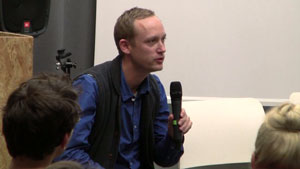
Tue Greenfort
Tue Greenfort presents on his recent projects, especially his work with water and an international water archive, as well as how this helps to understand changing landscapes and open dialogues on subjects such as biozone protection and the relation between computer science and thought.
Synthesis
dOCUMENTA (13) • Multi-species archive – human and non-human animals • Water archive • Water pollution and drinkability • Expand...
Danish artist living in Berlin • dOCUMENTA (13) • Multi-species archive – human and non-human animals • Water archive • Water pollution and drinkability • Place specific – samples from around the world • Symbolic value of objects • Closed ecosystem • What is the difference between an archive and a collection? • A collection that opens dialogue • Water as a political issue • Different approaches to water • Exhibition at SculptureCenter in New York • Hurricane Sandy • Reaction to the hurricane • The changing landscape of New York • How to re-think the environment in an urban area • The horseshoe crab • Evolutionary time scale • Dialogue on biozone protection • New York context • The relation between computer science and ecological thought
Short biography
Tue Greenfort, artist. As a participant in dOCUMENTA (13) in Kassel, Germany, Greenfort was co-curator of an archive on multi-species co-evolution, The Worldly House. Expand...
Tue Greenfort, artist. As a participant in dOCUMENTA (13) in Kassel, Germany, Greenfort was co-curator of an archive on multi-species co-evolution, The Worldly House. Solo presentations include Berlinische Galerie (2012), South London Gallery (2011), Kunstverein Braunschweig (2008), and Secession, Vienna (2007). Among his publications, the most comprehensive, Linear Deflection, was published by Walther König in 2009.
Tue Greenfort spricht über seine aktuellen Projekte, besonders seine Arbeit mit Wasser und seine Initiative für ein internationales Wasserarchiv. Außerdem thematisiert er, wie dies uns hilft, sich verändernde Landschaften zu verstehen und Diskurse zu Themen wie Biozonenschutz oder zu der Beziehung zwischen Computerwissenschaften und Theorie zu öffnen.
Synthese
dOCUMENTA (13) • Multispezies Archiv - menschliche und nichtmenschliche Tiere • Wasserarchiv • Wasserverschmutzung und Trinkbarkeit • Expand...
Dänischer Künstler der in Berlin wohnt • dOCUMENTA (13) • Multispezies Archiv - menschliche und nichtmenschliche Tiere • Wasserarchiv • Wasserverschmutzung und Trinkbarkeit • Ortsspezifisch – Proben von überall auf der Welt • Symbolischer Wert von Objekten • Geschlossene Ökosysteme • Was ist der Unterschied zwischen einem Archiv und einer Sammlung? • Eine Sammlung, die Dialoge eröffnet • Wasser als Politikum • Unterschiedliche Ansätze zum Thema Wasser • Ausstellung im SculptureCenter in New York • Hurrikan Sandy • Reaktionen auf den Hurrikan • Die sich verändernde Landschaft New Yorks • Wie denkt man die Umgebung in einer urbanen Gegend neu? • Der Pfeilschwanzkrebs • Evolutionärer Zeitrahmen • Dialog über Biozonenschutz • New York als Kontext • Die Beziehung zwischen Computerwissenschaft und ökologischen Gedanken
Kurzbiografie
Tue Greenfort, Künstler. Als ein Teilnehmer der dOCUMENTA (13) in Kassel war Greenfort Ko-Kurator eines Archivs für spezienübergreifende Ko-Evolution, The Worldly House. Expand...
Tue Greenfort, Künstler. Als ein Teilnehmer der dOCUMENTA (13) in Kassel war Greenfort Ko-Kurator eines Archivs für spezienübergreifende Ko-Evolution, The Worldly House. Soloschauen seiner Werke umfassen die Berlinische Galerie (2012), die South London Gallery (2011), den Kunstverein Braunschweig (2008), und Secession, Wien (2007). Die umfangreichste seiner Publikationen, Linear Deflection, wurde von Walther König im Jahr 2009 herausgegeben.
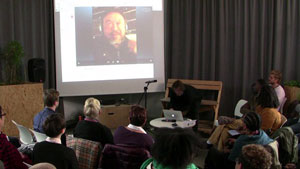
Olafur Eliasson & Ai Weiwei
Olafur Eliasson conducts a video interview with Ai Weiwei to introduce their collaboration, Moon, an online space where anyone can contribute a mark, a drawing, or an image to an integrated sphere. Through messages and non-verbal communication in a language unique to each person, the collective work becomes a testament to personal freedom, creativity, and activity.
Synthesis
Journeys and connections • Archival thinking • Retroactivity or proactivity? • Contemporary concept of the archive • Changing views • The objective vs. the subjective view of History • Expand...
Journeys and connections • Archival thinking • Retroactivity or proactivity? • Contemporary concept of the archive • Changing views • The objective vs. the subjective view of History • The emergent fields of Structuralism and Post-Structuralism in relation to archives • ‘To archive’ • Producing realities from archives • Subjectivity and the reality machine • The Moon Project • Ai Weiwei’s current situation • Secret police surveillance • Activating the Moon Project via video conference • Ai Weiwei’s work in relation to the history of culture • Human consciousness • Digital media • The Chinese political situation • The Dalai Lama • Their partnership on the Moon Project • Description of the project • Moon as an archive in the making • The ethico-political issues of an open project • How much to censor? • The symbolic nature of the Moon • The consequence of self-expression
Short biographies
Olafur Eliasson, a Danish-Icelandic artist, founded the Institut für Raumexperimente, an educational research project, affiliated with the College of Fine Arts at the Berlin University of the Arts (UdK) and supported by the Senate for Education, Science and Research in Berlin and the Einstein Foundation Berlin. The fundamental trajectory of the Institut für Raumexperimente is Eliasson’s interest in testing models of learning and cultivating experimental formats.
Ai Weiwei is a Chinese contemporary artist involved in art, design, sculpture, architecture, curating, photography, writing, film, and social, political, and cultural criticism. His activities mainly focus on freedom of expression and ways to support human rights and social justice.
Olafur Eliasson führt ein Videointerview mit Ai Weiwei um in ihre Zusammenarbeit für Moon, einem Online-Raum, in dem jeder ein Zeichen, eine Zeichnung oder ein Bild auf einer digitalen Mondoberfläche einschreiben kann, einzuführen. Die kollektive Arbeit wird durch Nachrichten und nonverbale Kommunikation in einer für jeden Beitragenden individuellen Sprache zu einem Zeugnis für persönliche Freiheit, Kreativität und Aktivität.
Synthese
Reisen und Verbindungen • Archivisches Denken • Retroaktivität oder Proaktivität? • Zeitgenössisches Konzept des Archivs • Sich ändernde Ansichten • Objektive versus subjective Sicht auf Geschichte • Expand...
Reisen und Verbindungen • Archivisches Denken • Retroaktivität oder Proaktivität? • Zeitgenössisches Konzept des Archivs • Sich ändernde Ansichten • Objektive versus subjective Sicht auf Geschichte • Das neue Gebiet von Strukturalismus und Post-Strukturalismus im Verhältnis zu Archiven • Archivieren • Schaffen von Realitäten aus Archiven • Subjektivität und die Realitätsmaschine • The Moon Project • Ai Weiweis aktuelle Situation • Überwachung durch Geheimpolizei • Aktivierung des Moon Project per Videokonferenz • Ai Weiweis Arbeit in Bezug zur Kulturgeschichte • Menschliches Bewusstsein • Digitale Medien • Die politische Situation in China • Der Dalai Lama • Ihre Zusammenarbeit beim Moon Project • Beschreibung des Projektes • Moon als entstehendes Archiv • Die ethnopolitischen Probleme eines offenen Projektes • Wieviel zensieren? • Die symbolische Natur des Mondes • Die Konsequenzen des persönlichen Ausdrucks
Kurzbiografien
Olafur Eliasson, dänisch-isländischer Künstler, gründete das Institut für Raumexperimente, ein Studien- und Forschungsprojekt, das Teil der Fakultät für Bildende Kunst an der Universität der Künste Berlin (UdK) ist. Eliassons Interesse, neue Lernmodelle zu testen und experimentelle Formate zu kultivieren, ist grundlegender Bestandteil des Institutsprogramms.
Ai Weiwei ist ein chinesischer zeitgenössischer Künstler, der sich mit Kunst, Design, Bildhauerei, Architektur, Kuration, Photografie, Schreiben, Film und sozialer, politischer sowie kultureller Kritik beschäftigt. Seine Aktivitäten beschäftigen sich hauptsächlich mit Meinungsfreiheit und der Unterstützung von Menschenrechten und sozialen Gerechtigkeit.
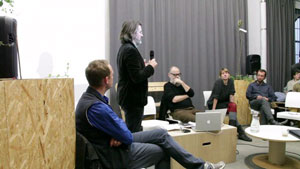
Olafur Eliasson
Olafur Eliasson presents his website as a living archive, exploring the definition of an archive and an archive’s nature as proactive or retroactive. His discussion is supplemented with examples from his own career and his online archive.
Synthesis
The start of an archive • The transition from one type of medium to another • A website as an archive • Sticky Rice – intuitive system • The internet as a gathering of material • Expand...
The start of an archive • The transition from one type of medium to another • A website as an archive • Sticky Rice – intuitive system • The internet as a gathering of material • A retroactive or proactive archive • More access to the work online than at exhibitions • Changing perspective of own work • How to represent online the process of producing work? • Examples of how his website functions • How to generate a system for viewing and cataloguing the work online? • Archive or catalogue? • Does an artist’s archive include the artwork? • Archival thinking as future co-production
Short biography
Olafur Eliasson, Danish-Icelandic artist, founded the Institut für Raumexperimente, an educational research project, affiliated with the College of Fine Arts at the Berlin University of the Arts (UdK) Expand...
Olafur Eliasson, Danish-Icelandic artist, founded the Institut für Raumexperimente, an educational research project, affiliated with the College of Fine Arts at the Berlin University of the Arts (UdK). The fundamental trajectory of the Institut für Raumexperimente is Eliasson’s interest in testing models of learning and cultivating experimental formats.
Olafur Eliasson präsentiert seine Website als lebendiges Archiv und diskutiert dabei die Definition des Archivs selbst sowie die Natur des Archivs als proaktiv beziehungsweise retroaktiv. Seine Überlegungen wurden durch Beispiele aus seiner eigenen Künstlerkarriere unterlegt.
Synthese
Der Beginn eines Archivs • Der Übergang von einer Art Medium zu einer anderen • Website als Archiv • Sticky Rice – intuitives System • Das Internet als Materialsammlung • Expand...
Der Beginn eines Archivs • Der Übergang von einer Art Medium zu einer anderen • Website als Archiv • Sticky Rice – intuitives System • Das Internet als Materialsammlung • Ein retroaktives oder proaktives Archiv • Online mehr Zugang zu Arbeiten als in der Ausstellung • Sich wandelnde Perspektiven auf das eigene Werk • Wie kann der Produktionsprozess eines Kunstwerkes online repräsentiert werden? • Beispiele wie seine Website funktioniert • Wie schafft man ein System zum Betrachten und Katalogisieren von Arbeiten online? • Archiv oder Katalog? • Enthält ein Künstlerarchiv die Kunstwerke? • Archivisches Denken als zukünftige Koproduktion
Kurzbiografie
Olafur Eliasson, dänisch-isländischer Künstler, gründete das Institut für Raumexperimente, ein Studien- und Forschungsprojekt, Expand...
Olafur Eliasson, dänisch-isländischer Künstler, gründete das Institut für Raumexperimente, ein Studien- und Forschungsprojekt, das Teil der Fakultät für Bildende Kunst an der Universität der Künste Berlin (UdK) ist. Eliassons Interesse, neue Lernmodelle zu testen und experimentelle Formate zu kultivieren, ist grundlegender Bestandteil des Institutsprogramms.